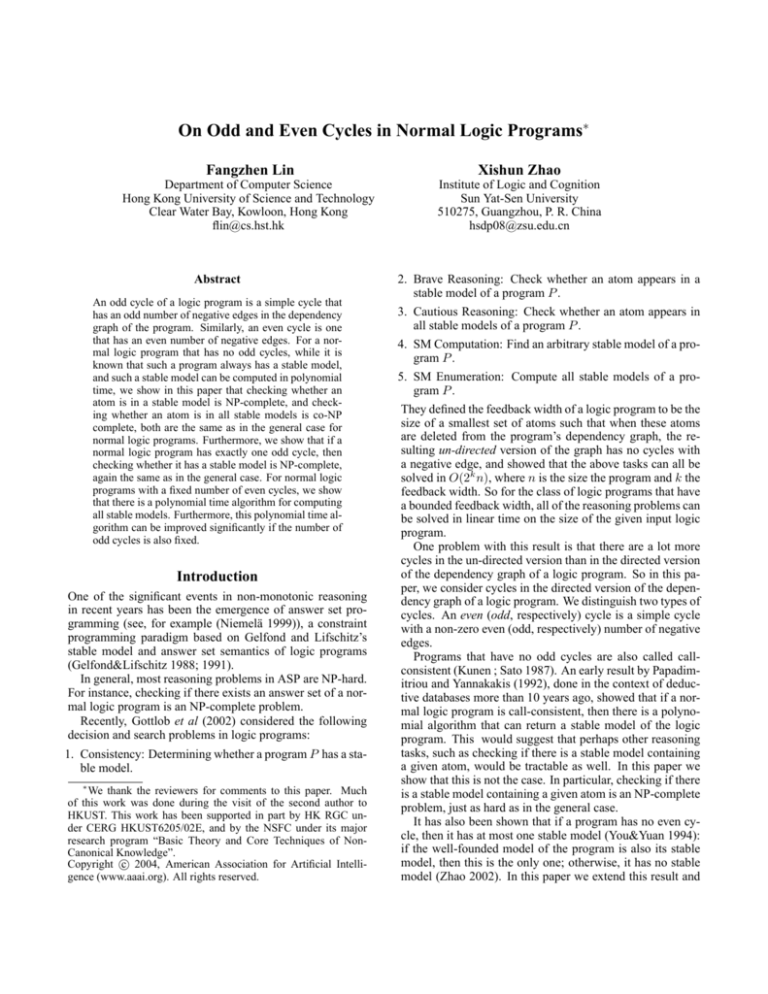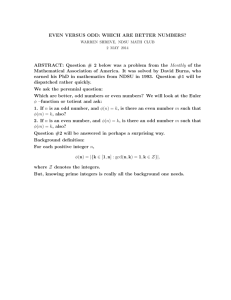
On Odd and Even Cycles in Normal Logic Programs∗
Fangzhen Lin
Xishun Zhao
Department of Computer Science
Hong Kong University of Science and Technology
Clear Water Bay, Kowloon, Hong Kong
flin@cs.hst.hk
Institute of Logic and Cognition
Sun Yat-Sen University
510275, Guangzhou, P. R. China
hsdp08@zsu.edu.cn
Abstract
An odd cycle of a logic program is a simple cycle that
has an odd number of negative edges in the dependency
graph of the program. Similarly, an even cycle is one
that has an even number of negative edges. For a normal logic program that has no odd cycles, while it is
known that such a program always has a stable model,
and such a stable model can be computed in polynomial
time, we show in this paper that checking whether an
atom is in a stable model is NP-complete, and checking whether an atom is in all stable models is co-NP
complete, both are the same as in the general case for
normal logic programs. Furthermore, we show that if a
normal logic program has exactly one odd cycle, then
checking whether it has a stable model is NP-complete,
again the same as in the general case. For normal logic
programs with a fixed number of even cycles, we show
that there is a polynomial time algorithm for computing
all stable models. Furthermore, this polynomial time algorithm can be improved significantly if the number of
odd cycles is also fixed.
Introduction
One of the significant events in non-monotonic reasoning
in recent years has been the emergence of answer set programming (see, for example (Niemelä 1999)), a constraint
programming paradigm based on Gelfond and Lifschitz’s
stable model and answer set semantics of logic programs
(Gelfond&Lifschitz 1988; 1991).
In general, most reasoning problems in ASP are NP-hard.
For instance, checking if there exists an answer set of a normal logic program is an NP-complete problem.
Recently, Gottlob et al (2002) considered the following
decision and search problems in logic programs:
1. Consistency: Determining whether a program P has a stable model.
∗
We thank the reviewers for comments to this paper. Much
of this work was done during the visit of the second author to
HKUST. This work has been supported in part by HK RGC under CERG HKUST6205/02E, and by the NSFC under its major
research program “Basic Theory and Core Techniques of NonCanonical Knowledge”.
c 2004, American Association for Artificial IntelliCopyright gence (www.aaai.org). All rights reserved.
2. Brave Reasoning: Check whether an atom appears in a
stable model of a program P .
3. Cautious Reasoning: Check whether an atom appears in
all stable models of a program P .
4. SM Computation: Find an arbitrary stable model of a program P .
5. SM Enumeration: Compute all stable models of a program P .
They defined the feedback width of a logic program to be the
size of a smallest set of atoms such that when these atoms
are deleted from the program’s dependency graph, the resulting un-directed version of the graph has no cycles with
a negative edge, and showed that the above tasks can all be
solved in O(2k n), where n is the size the program and k the
feedback width. So for the class of logic programs that have
a bounded feedback width, all of the reasoning problems can
be solved in linear time on the size of the given input logic
program.
One problem with this result is that there are a lot more
cycles in the un-directed version than in the directed version
of the dependency graph of a logic program. So in this paper, we consider cycles in the directed version of the dependency graph of a logic program. We distinguish two types of
cycles. An even (odd, respectively) cycle is a simple cycle
with a non-zero even (odd, respectively) number of negative
edges.
Programs that have no odd cycles are also called callconsistent (Kunen ; Sato 1987). An early result by Papadimitriou and Yannakakis (1992), done in the context of deductive databases more than 10 years ago, showed that if a normal logic program is call-consistent, then there is a polynomial algorithm that can return a stable model of the logic
program. This would suggest that perhaps other reasoning
tasks, such as checking if there is a stable model containing
a given atom, would be tractable as well. In this paper we
show that this is not the case. In particular, checking if there
is a stable model containing a given atom is an NP-complete
problem, just as hard as in the general case.
It has also been shown that if a program has no even cycle, then it has at most one stable model (You&Yuan 1994):
if the well-founded model of the program is also its stable
model, then this is the only one; otherwise, it has no stable
model (Zhao 2002). In this paper we extend this result and
show that a logic program with at most k even cycles has at
most 2k stable models.
In summary, the main results of this paper are as follows:
1. For call-consistent programs we show that the brave reasoning problem is NP-complete, and the cautious reasoning problem is co-NP-complete,
2. If a program has exactly one odd cycle (it could have any
number of even cycles), then the consistency problem is
NP-complete.
3. If a program has k even cycles (it could have any number
of odd cycles), then it has at most 2k stable models. Furthermore, the set of all stable models can be computed in
22k O(nk+2 ) time, where n is the size of the given program.
4. If the number of the total odd and even cycles of a logic
program is at most k, then we show that the set of all stable models of the program can be computed in 22k O(n2 )
time, where n is the size of the program.
As we shall see, besides of theoretical interests, these results
suggest that for computing answer sets of a logic program, a
good heuristic is to branch on the variable that would break
the most number of even cycles.
This paper is organized as follows. In section 2, we review some basic concepts of logic programming. In section
3, we prove our results for call-consistent programs. We
discuss programs with exactly one odd cycle in section 4,
programs with a fixed number of even cycles in section 5,
and programs with a fixed number of odd and even cycles in
Section 6. We conclude this paper in section 7.
Preliminaries
We consider only normal propositional logic programs,
which are finite sets of rules of the following form
r:
a ← b1 , · · · , bm , not c1 , · · · , not cn ,
where r is the name of the rule, a, bi , 1 ≤ i ≤ m, and cj ,
1 ≤ j ≤ n are atoms, and m + n ≥ 1. In the following,
we let Head(r)=a (the head of r), Pos(r)={b1 , · · · , bm } (the
positive body of r), and Neg(r)={c1 , · · · , cn } (the negative
body of r). The body of r is Pos(r) ∪ Neg(r).
In the following, given a (normal) logic program P , we
denote by At(P ) the set of atoms occurring in P . We shall
also call atoms positive literals. A negative literal is an expression of the form not a, where a is an atom. A literal is
either a positive or a negative literal.
Given a logic program P , S ⊆ At(P ) is said to be a stable
model (Gelfond&Lifschitz 1988) of P if S = Cons(PS ),
where PS is obtained from P and S by the following
Gelfond-Lifschitz transformation:
(1) for each atom p and any rule r ∈ P , if p ∈ Neg(r) and
p 6∈ S, then remove not p from r, and
(2) in the set of remaining rules, delete those rules that still
contain a negative literal in their bodies,
and Cons(PS ) is the set of atoms derivable from the definite
logic program PS .
A logic program may have zero, one, or more than one
stable models. In comparison, the well-founded model semantics (Van Gelder et al 1991) produces a unique 3-valued
model for a normal logic program. Formally, a 3-valued
interpretation I is a pair of two disjoint sets of atoms,
(I + , I − ). Atoms in I + are assigned true and those in I −
false. Atoms occurring in neither I + nor I − are undefined.
Given a logic program P , the operation ΓP defined by
ΓP (S) := Cons(PS ), is anti-monotone, i.e., if S1 ⊆ S2
then ΓP (S2 ) ⊆ ΓP (S1 ). Thus the operation Γ2P , defined as
Γ2P (S) := ΓP (ΓP (S)), is monotone. Therefore, Γ2P has the
least fixed-point, say S, and the greatest fixed-point, say T .
The well-founded model of P is (S, At(P ) − T ).
The well-founded model can be computed in quadratic
time (Van Gelder et al 1991), and has been used to simplify
a logic program in almost all of the current answer set programming systems.
In the following, we denote by WFM(P )
=
(WFM(P )+ , WFM(P )− ) the well-founded model of
P . We use WFM(P ) to simplify P as follows:
(1) Delete all rules r ∈ P such that either Head(r) ∈
WFM+ (P ), Pos(r) ∩ WFM− (P ) 6= ∅, or Neg(r) ∩
WFM+ (P ) 6= ∅.
(2) From the bodies of the remaining rules, remove all positive literals in WFM+ (P ) and all negative literals not q
with q ∈ WFM− (P ).
The resulting program is written as P \ WFM(P ).
The dependency graph (Apt et al 1988) of a normal logic
program P , denoted by GP , is a directed graph with signed
edges. The vertices of GP are atoms in At(P ). There is
a positive (negative, respectively) edge from a vertex p to
a vertex q if there is a rule r ∈ P such that Head(r) = q
and p ∈ Pos(r) (p ∈ Neg(r), respectively). Informally, a
positive (negative, respectively) edge from p to q means that
q depends positively (negatively, respectively) on p.
If a simple cycle of GP has an odd (a non-zero even, respectively) number of negative edges then we call it an odd
(even, respectively) cycle. In the following, we denote by
NOC(P ) (NEC(P ), respectively) the number of odd (even,
respectively) cycles in the dependency graph of P .
Call-Consistent Programs
As mentioned earlier, a call-consistent program is a normal
logic program that has no odd cycles. It has been shown that
a call-consistent program always has a stable model, and
such a stable model can be computed in polynomial time.
Despite this, checking if an atom is in a stable model of a
call-consistent program is still NP-complete, and checking
if an atom is in all the stable models of a call-consistent program is still co-NP complete.
Theorem 1
(a) Brave reasoning for call-consistent programs is NPcomplete.
(b) Cautious reasoning for call-consistent programs is coNP-complete.
Proof. (Sketched) Memberships in NP for (a), and co-NP for
(b) is obvious. For hardness, consider a set ϕ of clauses with
variables x1 , ..., xn . Let y1 , ..., yn , a and b be new variables.
Let P (ϕ) be the program consisting of rules in the following
groups.
(I) For each xi (1 ≤ i ≤ m), the rules:
yi ← not xi , xi ← not yi .
(II) For each C in ϕ, the rule: a ← C, where for a clause
C, if ¬x ∈ C, then x ∈ C, and if an atom x ∈ C, then
not x ∈ C.
(III) The single rule: b ← not a.
The only cycles of P (ϕ) are generated by rules in group (I),
and they are all even cycles. Thus the program is a callconsistent.
We show that ϕ is satisfiable iff b is in at least one stable
model of P (ϕ), and ϕ is unsatisfiable iff a is in every stable
model of P (ϕ). From these, the NP-hardness of the brave
reasoning, and the co-NP-hardness of the cautious reasoning
follow.
Suppose ϕ is satisfiable. We can then generate a truth assignment satisfying it using the rules in (I). Under this truth
assignment, rules in group (II) are not applicable. Hence we
can not use them to get a. In this case, we get b by using
the rule in (III). Therefore, we get a stable model of P (ϕ)
containing b. Suppose ϕ is not satisfiable. Then any truth
assignment makes some clause C in ϕ false, and hence the
rule in (II) is applicable. Thus, a is in every stable model of
P (ϕ).
Notice that a well-known technique for finding a stable model containing an atom a is to add the constraint
“← not a” to the original logic program. According to our
theorem, and the fact that there is a polynomial time algorithm that can return a stable model of a call-consistent logic
program, one cannot replace this constraint by a polynomial
number of rules without introducing some odd cycles unless
the polynomial hierarchy collapses.
It is worth mentioning here that in disjunctive logic
programs, the so-called head-cycle free programs (BenEliyahu-Zohary&Paloponi 1997; Ben-Eliyahu-Zohary et all
2000) appear to exhibit similar properties like call-consistent
programs. In particular, finding one answer set is tractable
for these disjunctive logic programs, but brave reasoning and
cautious reasoning are hard.
Programs with Exactly One Odd Cycle
Programs with odd cycles may or may not have stable models. For instance, consider the following programs
P0 = {b ← not a, c ← not b, a ← not c},
P1 = P0 ∪ {a ←}.
Both have exactly one odd loop, but P0 has no stable model
while P1 has one {a, c}.
In general, even cycles generate models while odd cycles
eliminate models. For instance, the following set of rules
{x1 ← not y1 , y1 ← not x1 , · · · , xn ← not yn ,
yn ← not xn }
(1)
has n even cycles and 2n stable models. Now if we add an
odd cycle such as x1 ← not x1 to it, then in principle, we
may have to go through all these 2n models before we are
sure that there is no stable model of the new program.
This is basically the reason why the consistency problem
for programs with exactly one odd cycle is intractable.
Theorem 2 The consistency problem for programs whose
dependency graphs have exactly one odd cycle is NPcomplete.
Proof. Membership in NP is obvious. The proof of hardness
is similar to that of Theorem 1. Consider again a set ϕ of
clauses with variables x1 , ..., xn . Let y1 , ..., yn , a and b be
new variables. Let P (ϕ) be as in the proof of Theorem 1 but
with the rule (III) replaced by the following rule:
(III’) b ← a, not b.
Clearly, P (ϕ) has exactly one odd cycle formed by rule
(III’), and it has a stable model if and only if ϕ is satisfiable.
Programs with a Fixed Number of Even Cycles
From the result in the last section, we see that restricting
the number of odd cycles to a fixed positive number cannot
reduce the complexity. As we mentioned above, the reason
is that even cycles can generate an exponential number of
models. We now consider what happens if we restrict the
number of even cycles.
As mentioned in Introduction, if a program has no even
cycle, then it has at most one stable model (You&Yuan
1994). Furthermore, if the well-founded model of the program is also its stable model, then this is the only one; otherwise, it has no stable model (Zhao 2002). To study the general case, we first introduce the following definition, which
was first introduced in (Cholewinski&Truszczynski 1999).
Definition 1 Let P be a program, and a an atom in At(P ).
Define Pa+ to be the program obtained from P by
1. deleting all rules whose bodies contain not a, and
2. removing a from the bodies of remaining rules.
Similarly define Pa− to be the program obtained from P by
1. deleting all rules whose bodies contain a, and
2. removing not a from the remaining rules.
Notice that GPa+ , GPa− are subgraphs of GP , and that in
GPa+ , GPa− there are no edges going out from a.
Lemma 1 (Cholewinski&Truszczynski 1999) Let P be a
program, a ∈ At(P ). Suppose S is a stable model of P .
Then
1. If a ∈ S then S is a stable model of Pa+ .
2. If a 6∈ S then S is a stable model of Pa− .
Cholewinski and Truszczynski (1999) also proved that a program with n rules has at most O(3n/3 ) stable models. Our
following result gives the upper bound of the number of stable models according to the number of even cycles.
Recall that for a program P , NEC(P ) denotes the number
of even cycles in P , and NOC(P ) the number of odd cycles
in P .
Lemma 2 Let P be a program such that NEC(P ) ≤ k.
Then P has at most 2k stable models.
Proof. We show the theorem by induction on k, here k is
NEC(P ).
If k = 0 then the lemma follows from the aforementioned
result by You and Yuan (1994). Suppose NEC(P ) ≥ 1.
Then pick an atom a ∈ At(P ) such that a occurs in an even
cycle. Please note that GPa+ , GPa− are subgraphs of GP , and
that in GPa+ , GPa− there are no edges going out from a.Thus
NEC(Pa+ ) ≤ k−1 and NEC(Pa− ) ≤ k−1. By the induction
hypothesis, Pa+ (Pa− , respectively) has at most 2k−1 stable
models. By the above lemma, we know that P has at most
2k−1 + 2k−1 = 2k stable models.
From these two lemmas, and the fact that when NEC(P ) is
zero, either P has no stable model or its well-founded model
is its stable model, a naive way to compute the stable models
of a program with NEC(P ) ≤ k is to choose an atom a that
lies in an even cycle, split the current program P into Pa+
and Pa− , and then inductively compute the stable models of
Pa+ and Pa− , which have fewer numbers of even cycles than
P . Unfortunately, finding an atom that lies in an even loop
of a program is an intractable problem:
Lemma 3 Given a program P and an atom a. The problem
of determining whether a lies in an even cycle of GP is NPcomplete.
Proof. (Sketched) The proof of this this lemma is similar
to the proof of Theorem 16 of (Gottlob et al 2002). The
membership in NP is obvious. To prove the hardness we
reduce the node-disjoint path problem for directed graphs,
which is a NP-complete problem (Garey&Johnson 1979), to
our problem.
Let G = (N, E) be a directed graph, and x1 , y1 and x2 , y2
two pairs of nodes of G.
The problem is deciding whether there are two node-disjoint
paths linking x1 to x2 and y1 to y2 . From G, we construct a
logic program P (G) containing a rule t ← s for each edge
(s, t) ∈ E, plus two additional rules x1 ← not y2 , and
y1 ← not x2 .
We can show that x1 lies in an even cycle in PG if and only
if there are two node-disjoint paths linking x1 to x2 and y1
to y2 in G.
So instead of looking for an atom that lies in an even cycle
of a program, and split the program on the atom, we simply
split the program on every atom of the program. This is the
basic idea behind our algorithm for computing Ans(P, k) in
Figure 1.
Lemma 4 Let k be a fixed natural number, P a program
with NEC(P ) ≤ k. Then every stable model of P appears
in Ans(P, k).
Proof. We prove the assertion by induction on k. When
k = 0, the assertion follows from the known result. Suppose
k > 0. If the dependency graph GP has an even cycle,
then the cycle will be broken in GPa+ and GPa− for some
a. That is, NEC(Pa+ ) ≤ k − 1 and NEC(Pa− ) ≤ k − 1.
By the induction hypothesis, all stable models of Pa+ (Pa− ),
respectively) appear in Ans(Pa+ , k − 1) (Ans(Pa− , k − 1),
respectively). Now the lemma follows from Lemma 2.
Function Ans(P, k)
Input A normal program P , and a natural number k.
Output A set of stable models of P
begin
if k = 0 then
if WFM+ (P ) is a stable model of P then return
{WFM+ (P )} else return ∅.
Π := ∅.
for each atom a ∈ At(P )
for each S ∈Ans(Pa+ , k − 1)∪Ans(Pa− , k − 1)
if S is a stable model of P then Π := Π ∪ {S}.
return Π
end
Figure 1: An algorithm for computing the stable models of
a logic program with at most k even cycles
Lemma 5 Let P be a program, and k a fixed natural number. Then
1. Ans(P, k) contains at most 2k nk sets, where n is the size
of P .
2. Ans(P, k) can be computed in 22k O(nk+2 ) time.
Proof. (1) We shall proceed by induction on k. The assertion clearly holds when k = 0. Suppose k > 0. By the
induction hypothesis, Ans(Pa+ , k − 1) (Ans((Pa− , k − 1), respectively) contains at most 2k−1 nk−1 sets for each atom a.
Thus, Ans(P, k) has at most 2n(2k−1 nk−1 ) = 2k nk sets.
(2) We shall prove the claim by induction on k. When k = 0
the claim is obviously valid because the well-founded model
can be computed in quadratic time and to check whether it
is a stable model costs not more than quadratic time. Suppose k > 0. By the induction hypothesis, to compute
Ans(Pa+ , k − 1) and Ans(Pa− , k − 1) for all a will cost time
not more than
2n(22(k−1) nk+1 ) = 22k−1 nk+2 .
From (1), to check whether the sets in all Ans(Pa+ , k − 1) ∪
Ans(Pa− , k − 1) are stable models needs time not more than
2n(2k−1 nk−1 )O(n2 ) = 2k O(nk+2 ).
Altogether, the total running time is
22k−1 nk+2 + 2k nk+2 ≤ 22k nk+2 .
From these two lemmas we obtain the following theorem.
Theorem 3 For an arbitrary fixed natural number k, the set
of stable models of a program with at most k even cycles can
be computed in 22k O(nk+2 ) time, where n is the size of P .
Notice that in the theorem, the time complexity is
bounded by nk+2 which is a polynomial whose degree depends on the parameter k. It remains an open question
whether there is an algorithm computing all stable models
in time bounded by a polynomial whose degree does not depend on k. In the next section, we show that this is true for
logic programs with at most k total number of odd and even
cycles.
Function All-Ans(P )
Input: A normal program P
Output: The set of stable models of P
begin
if WFM+ (P ) is a stable model of P then return
{WFM+ (P )}.
Q := P \ WFM(P ) (now Q is non-empty).
compute a bottom H of Q.
pick an atom a ∈ H such that there is another atom b in H,
and a negative edge a to b in GQ .
Π := ∅.
for each S ∈ All-Ans(Pa+ )∪ All-Ans(Pa− )
if S is a stable model of P then Π := Π ∪ {S}
return Π
end
Figure 2: An algorithm for computing the stable models of
a logic program
Programs with a Fixed Number of Cycles
In this section we show that for any given k, there is an algorithm that computes in quadratic time all stable models of
any given program P with NEC(P ) + NOC(P ) ≤ k.
Recall that a strongly connected component of a graph is
a set of nodes such that for any two nodes in the set, there
is a path from one node to the other, and it is not a proper
subset of any such sets. There is a linear time algorithm that
can compute all strongly connected components of a graph
(Tarjan 1972).
Given a normal program P , we call a set B of atoms a
bottom if it is a strongly connected component of GP , and
there is no other strongly connected component B 0 such that
there is a path from an atom in B 0 to another atom in B.
Proposition 1 Let P be a normal logic program. If Q =
P \ WFM(P ) is not empty, then every bottom of Q must
have a pair of nodes a and b such that there is a negative
edge from a to b.
Proof. We prove by contradiction. Suppose Q is not empty,
H is a bottom of Q, and all paths in H are positive.
Let R(H) = {r ∈ Q | Head(r) ∈ H}. Since H is a bottom
of Q, and Q is the result of simpifying P by its well-founded
model, there cannot be any atom p in Q such that p 6∈ H, and
there is a path from p to an atom in H. For otherwise, since
there is no more cycles below p, its truth value would have
been dertermined in the well-founded model of P , thus eliminated when P is simplified using its well-founded model.
Thus the bodies of all rules in R(H) must all be in H. As
a consequence, no rule in R(H) can have a negative literal
in its body. Moreover, since Q = P \ WFM(P ), every rule
in Q has to have a non-empty body. Then according to the
procedure for calculating well-founded models, all atoms in
H are false in the well-founded model of P , and hence they
cannot occur in Q. This contradicts the assumption that H
is a strongly connected component of Q.
Lemma 6 Let P be a normal logic program. Then AllAns(P ) defined in Figure 2 contains all stable models of P .
Proof. We show the theorem by induction on k, the number
of cycles of GP .
When k = 0, i.e., NEC(P )=NOC(P )=0, the theorem follows from the fact that P has exact one stable model which
is the well-founded model of P .
Suppose k > 0 , and NEC(P )+NOC(P ) = k. If WFM(P )
is a stable model of P , then it is the unique stable model of
P , and the theorem follows. So, we assume that WFM(P )
is not a stable model of P . Thus Q := P \ WFM(P ) is not
empty. Suppose H is a bottom of Q, let a and b be two atoms
in H such that there is a negative edge from a to b. Since
H is a connected component, there must a path from b to a.
Thus, there is at least one cycle in H that goes through the
negative edge from a to b. Then NEC(Pa+ )+NOC(Pa+ ) ≤
k − 1, and NEC(Pa− ) + NOC(Pa− ) ≤ k − 1. We know that
every stable model of P is a stable model of either Pa+ or
Pa− . By the inductive assumption, every stable model of Pa+
(Pa− , respectively) appears in All-Ans(Pa+ ) (All-Ans(Pa− ),
respectively). Therefore, every stable model of P appears in
All-Ans(P ).
Lemma 7 For each fixed natural number k, the function in
Figure 2 runs in time 22k O(n2 ) for any given program P
such that NEC(P )+NOC(P ) ≤ k, where n is the size of P .
Proof.
We proceed by induction on k. When k = 0,
the lemma follows from the fact that P has exact one stable
model, i.e., the well-founded model, which can be computed
in quadratic time and that to check whether the well-founded
model is a stable model costs no more than quadratic time.
Suppose k > 0. To compute the well-founded model of a
program costs quadratic time, to computer a bottom takes
linear time, and the atom a and Pa+ , Pa− can be computed in
linear time. By the inductive assumption, to compute AllAns(Pa+ ) and All-Ans(Pa− ) costs not more than
22(k−1) O((n − 1)2 ) + 22(k−1) O((n − 1)2 ) ≤ 22k−1 O(n2 )
time. From Lemma 2, we know that All-Ans(Pa+ ) ∪
All-Ans(Pa− ) has at most 2k elements. Thus to check
whether they are stable models of P needs no more than
time 2k O(n2 ).
Altogether the algorithm costs no more than
O(n2 ) + O(n) + 22k−1 O(n2 ) + 2k O(n2 ) ≤ 22k O(n2 )
By Lemmas 6 and 7 we obtain the following theorem.
Theorem 4 The set of all stable models of a program with
a fixed number of even and odd cycles can be computed in
quadratic time 22k O(n2 ), where k is the number of even and
odd loops, and n the size of the given program.
We want to emphasize that this result assumes a fixed k,
and the co-efficient 22k means that this number should not
be too big for the algorithm in Figure 2 to be practical. Of
course, this is the worst case complexity. Problems normally
encountered in practice could be much easier even for large
k.
Conclusions
We have performed a detailed complexity analysis of normal
logic programs with a limited number of odd and/or even
cycles. To recast, for a normal logic program without any
odd cycles, others have shown that it always has stable models (Dung 1992; You&Yuan 1994), and one of them can be
computed in polynomial time (Papadimitriou&Yannakakis
1992). What we have shown here is that despite these positive results, given an atom, checking whether it is in one of
its stable models is an NP-complete problem, and checking
whether it is in all of its stable models is a coNP-complete
problem. We have also shown that if we relax the condition
a little bit, allowing just one odd cycle, then whether there is
a stable model becomes an NP-complete program, the same
as in the general case.
For a normal logic program without even cycles, others
have shown that it has at most one stable model (You&Yuan
1994), and if it has a stable model, then the stable model
must also be its well-founded model (Zhao 2002). We have
extended these results, and shown that if a normal logic program has at most k even cycles, then it has at most 2k stable
models, and all of them can be computed in polynomial time
for the fixed parameter k.
It is clear that there is a disparity between the results for
programs with a limited number of odd cycles and those for
programs with a limited even cycles. The reason is that these
two types of cycles play very different roles. The even cycles
are stable model generators, and the odd cycles are stable
model eliminators.
We believe that our results are not just of theoretical interest. The algorithms in Figures 1 and 2, suggest that for
computing answer sets of general logic programs, a good
heuristic is to choose the next variable that would break the
most number of even cycles. The key of course is how to
efficiently compute the variables that would break a large
number of even cycles. One future work for us is to address
this problem and to experiment with this heuristic.
References
Apt, K.R., Blair, H.A., and Walker, A. 1988. Towards a Theory
of Declarative Knowledge. In Foundation of Deductive Database
and Logic Programming (ed. J. Minker), 293–322, Morgan Kaufmann, Los Altos, 1988.
Apt, K.R., and Bol, R.N., 1994. Logic Programming and Negation: A Survey. Journal of Logic Programming 19/20:9–71.
Ben-Eliyahu-Zohary, R. and Paloponi, L. 1997. Reasoning with
minimal models: efficient algorithms and applications. Artificial
Intelligence 96(2):421–449.
Ben-Eliyahu-Zohary, R., Paloponi, L., and Zemlyanker, V. 2000.
More on tractable disjunctive datalog. Journal of Logic Programming 46(1-2):61–101.
Bidoit, N., and Froidevaux, C. 1991. Negation by Default and Unstratifible Logic Programs. Theoretical Computer Science 78:85–
112.
Cholewinski, P., and Truszczynski, M. 1999. Extremal Problems
in Logic Programming and Stable Model Computation. Journal
of Logic Programming 38:219–242.
Dung, P.M. 1992. On the Relation between Stable and WellFounded Semantics of Logic Programs. Theoretical Computer
Science: Logic, Semantics and Theory of Programming 105:7–
26.
Eiter, T., Leone, N., Mateis, C., Pfeifer, G., and Scarnello, F.
1998. The KR-System DLV: Progress Report, Comparison and
Benchmarks. In Proceedings of the 6th International Conference
on Principles of Knowledge Representation and Reasoning, 406–
417. Morgan Kaufmann Publishers.
Garey, M.R., and Johnson, D.S. 1979. Computers and Intractability, A Guide to the Theory of NP-Completeness. Freeman,
Newyork.
Gelfond, M., and Lifschitz, V. 1988. The Stable Model Semantics
for Logic Programming. In Proceedings of the 5th International
Conference on Logic Programming, 1070–1080. The MIT Press.
Gelfond, M., Lifschitz, V., 1991. Classical Negation in Logic Programs and Disjunctive Database. New Generation Computing 9:
365–385.
Gottlob, G., and Scarcello, F., and Sideri, M. 2002. FixedParameter Complexity in AI and Nonmonotonic Reasoning. Artificial Intelligence 138:55–86.
Kleine Büning, H., and Lettmann, T. 1999. Propositional Logic:
Deduction and Algorithms. Cambridge University Press.
Kunen, K. 1989. Signed Dada Dependencies in Logic Programs.
Journal of Logic Programming, 7:231–245.
Lifschitz, V., and Turner, H. 1994. Splitting a Logic Program. In
Proceedings of International Conference on Logic Programming,
23–37.
Lin, F., and You, J.H. 2002. Abduction in Logic Programming: A
New Definition and an Abductive Procedure Based on Rewritting.
Artificial Intelligence, 140(1/2):175–205.
Lin, F., and Zhao, Y. 2002. ASSAT: Computing Answer Sets of
a Logic Program by SAT Solvers. In Proceedings of AAAI-2002,
112–117.
Niemelä, I. 1999. Logic Programs with Stable Model Semantics
as a Constraint Programming Paradigm. Annals of mathematics
and Artificial Intelligence 25:241–273.
Papadimitriou, C.H., and Yannakakis, M. 1992. Tie-Breaking Semantics and Structural Totality. In Proceedings of 11th ACM conference on Principles of Database Systems (PODS 1992), 16–22.
Sato, T. 1987. On the Consistency of First-Order Logic Programs,
ETL Technique Report, TR-87-12.
Tarjan, R.E. 1972. Depth-First Search and Linear Graph Algorithms, SIAM Journal of on Computing 1:146–160.
Van Gelder, A., Ross, K.R., and Schlipf, J.S. 1991. The WellFounded Semantics for General Logic Programs. Journal of the
ACM 38:620–650.
You, J.H., and Yuan, L. 1994. A Three-Valued Semantics for Deductive Database and Logic Programs. Journal of Computer and
System Science 49:334–361.
Zhao, J. 2002. A Study of Answer set Programming, MPhil Thesis, Dept. of Computer Science, The Hong Kong University of
Science and Technology.







